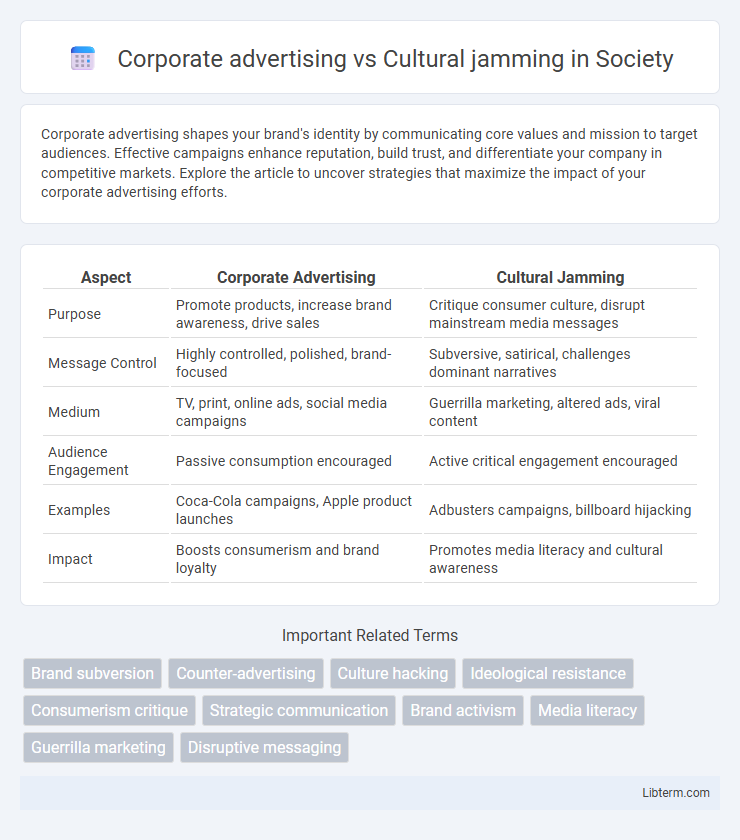Corporate advertising shapes your brand's identity by communicating core values and mission to target audiences. Effective campaigns enhance reputation, build trust, and differentiate your company in competitive markets. Explore the article to uncover strategies that maximize the impact of your corporate advertising efforts.
Table of Comparison
| Aspect | Corporate Advertising | Cultural Jamming |
|---|---|---|
| Purpose | Promote products, increase brand awareness, drive sales | Critique consumer culture, disrupt mainstream media messages |
| Message Control | Highly controlled, polished, brand-focused | Subversive, satirical, challenges dominant narratives |
| Medium | TV, print, online ads, social media campaigns | Guerrilla marketing, altered ads, viral content |
| Audience Engagement | Passive consumption encouraged | Active critical engagement encouraged |
| Examples | Coca-Cola campaigns, Apple product launches | Adbusters campaigns, billboard hijacking |
| Impact | Boosts consumerism and brand loyalty | Promotes media literacy and cultural awareness |
Defining Corporate Advertising
Corporate advertising involves strategically crafted promotional campaigns aimed at enhancing a company's brand image, boosting consumer loyalty, and driving sales through positive messaging across multiple media platforms. It typically emphasizes values, achievements, and product benefits to shape public perception and differentiate the corporation in competitive markets. This form of advertising aligns closely with business objectives, focusing on reinforcing corporate identity and market positioning.
Understanding Cultural Jamming
Cultural jamming challenges traditional corporate advertising by subverting and disrupting mainstream media messages to critique consumerism and corporate power. It uses satire, parody, and detournement to expose hidden agendas and encourage critical thinking about brand narratives. Understanding cultural jamming involves recognizing its role as a form of social and political activism aimed at reclaiming public space from corporate influence.
Historical Context of Both Movements
Corporate advertising emerged in the late 19th and early 20th centuries alongside industrialization and mass media expansion, aiming to promote products and build brand loyalty through persuasive messaging. Cultural jamming originated in the late 20th century as a grassroots activist response critiquing consumerism and corporate power, using subversive techniques to disrupt and parody traditional advertising. The historical context reflects a shift from the dominance of corporate influence in public spaces to a reactive counter-movement challenging media narratives and consumer culture.
Key Motivations Behind Corporate Advertising
Corporate advertising primarily aims to increase brand awareness, drive sales, and build long-term customer loyalty by strategically promoting products and services to target audiences. Companies invest in data-driven campaigns to shape consumer perceptions, influence purchasing decisions, and differentiate themselves in competitive markets. The key motivations include maximizing revenue, expanding market share, and reinforcing brand identity through consistent messaging and emotional appeals.
Core Objectives of Cultural Jamming
Cultural jamming aims to disrupt and challenge dominant corporate messages by subverting advertising's persuasive intent and exposing consumer manipulation tactics. It seeks to raise awareness about social, political, and environmental issues often obscured by mainstream media through creative, satirical interventions. Unlike corporate advertising, which drives brand loyalty and sales growth, cultural jamming prioritizes critical thinking and social change.
Visual Strategies and Techniques Compared
Corporate advertising employs polished visuals, bold typography, and consistent brand colors to create clear, persuasive messages that reinforce brand identity and consumer loyalty. Cultural jamming uses subversive imagery, irony, and detournement--repurposing corporate logos and advertisements--to critique and disrupt mainstream media narratives. While corporate advertising aims for clarity and brand coherence, cultural jamming leverages visual disruption and satire to provoke critical thinking and challenge consumer culture.
Audience Reception and Public Perception
Corporate advertising often aims to create positive brand awareness through targeted messages that resonate with specific demographics, resulting in generally favorable audience reception and increased consumer trust. Cultural jamming, by contrast, uses subversive and satirical techniques to challenge dominant corporate narratives, provoking critical public perception and encouraging skepticism toward mainstream advertising. The contrasting approaches lead to divergent audience engagements: acceptance and loyalty for corporate ads versus awareness and activism stimulated by cultural jamming.
Impact on Consumer Behavior
Corporate advertising shapes consumer behavior by reinforcing brand loyalty through targeted messaging and emotional appeals, often driving increased purchasing and brand recognition. Cultural jamming disrupts these influences by exposing the manipulative tactics behind advertisements, encouraging consumers to question and resist commercial messages. This critical awareness can lead to more deliberate consumption choices and a decline in passive acceptance of corporate narratives.
Ethical Considerations in Messaging
Corporate advertising often prioritizes persuasive messaging aimed at boosting sales, which can raise ethical concerns about manipulation, consumer deception, and reinforcing materialistic values. Cultural jamming counters these issues by subverting corporate messages to highlight social injustices, promoting transparency and critical thinking as ethical imperatives in media consumption. The ethical landscape of messaging requires balancing truthful communication with respect for audience autonomy and social responsibility.
Future Trends: Convergence or Conflict
Corporate advertising increasingly integrates immersive technologies and personalized data analytics to enhance brand engagement, driving future trends toward convergence with cultural jamming tactics that exploit similar digital platforms for subversion. Emerging AI tools enable both advertisers and cultural jammers to design hyper-targeted content, creating a battleground where message control and consumer perception blur. The ongoing evolution in social media algorithms further complicates this dynamic, amplifying conflicts over narrative dominance while fostering innovative hybrid strategies that blend promotional and disruptive elements.
Corporate advertising Infographic

 libterm.com
libterm.com